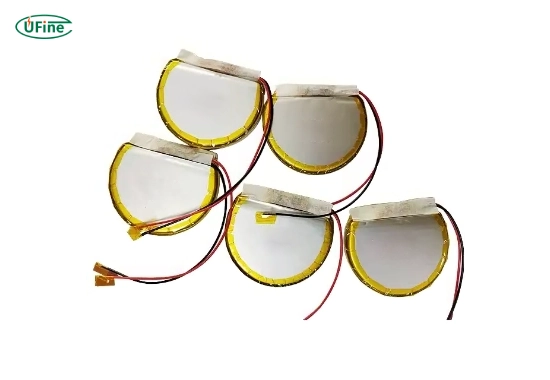What is a flat-circle battery? A flat-circle battery is a slim, round power source designed for compact electronic devices. It offers high energy density with minimal space. It’s especially popular in modern tech, where saving space is just as important as delivering reliable power.
From wearables and medical devices to smart sensors and wireless gadgets, the flat circle battery, particularly the lithium-ion version, is revolutionizing how we power portable electronics. Its unique design, lightweight build, and long-lasting performance make it a top choice for engineers and manufacturers worldwide.
In this guide, we’ll explore everything you need to know about the flat circle battery, focusing on its lithium-ion variant, advantages, design features, and real-world applications.
Part 1. What is a flat-circle battery?
A flat circle battery is a type of battery with a disc-like, thin, and circular shape designed to fit into small, space-limited electronic devices. Its flat round form is ideal for low-profile applications, unlike cylindrical or prismatic batteries.
When discussing flat circle batteries, we often refer to coin cells, button cells, or more advanced flat lithium-ion cells. These batteries are commonly found in:
- Smartwatches
- Fitness trackers
- Bluetooth earphones
- Medical implants
- Remote controls
- IoT sensors
Though small, these batteries can be powerful, especially when built with lithium-ion chemistry.
Artikel Terkait: Flat Circle Battery vs. Traditional Lithium-ion Cells: A Technical Comparison
Part 2. How does a flat-circle lithium-ion battery work?
A flat-circle lithium-ion battery moves lithium ions between the anode and cathode during charging and discharging cycles.
Here’s a simple breakdown:
- When charging, lithium ions move from the cathode to the anode.
- When discharging, they move back to the cathode, releasing energy.
- This process can repeat hundreds of times, making lithium-ion batteries rechargeable and efficient.
The flat circular design is achieved by using thin layers of electrode materials, wound or stacked inside a round, flat casing. The goal is to maximize surface area while keeping the profile slim.
Part 3. What makes the flat circle battery unique?
There are many battery shapes available, but the flat circle battery stands out for several reasons:
- ✅ Ultra-thin design
Its compact profile lets it fit inside slim devices like wearables and implantable medical tools. - ✅ Lightweight
It adds minimal bulk, which is critical for comfort in wearables or miniature sensors. - ✅ Stable voltage
Especially in lithium-ion versions, it offers consistent power output, which is essential for sensitive electronics. - ✅ Flexible usage
It can be used horizontally, vertically, or even stacked in modular systems.
Part 4. Why lithium-ion chemistry matters
While flat circle batteries come in various chemistries (like silver oxide or alkaline), lithium-ion is by far the most powerful and adaptable.
Key benefits of lithium-ion flat circle batteries:
- High energy density: More power in a smaller space.
- Rechargeable: Can be charged and discharged hundreds of times.
- Low self-discharge: Retains charge for months when not in use.
- Long cycle life: Typically 300–1000+ charge cycles.
- Safe with proper protection: Modern cells have built-in safety circuits.
These properties make lithium-ion flat-circle batteries the top choice for next-gen electronics.
Part 5. What are the most common types and sizes?
Flat circle batteries are defined by their diameter, thickness, and chemistry. Here are some of the most popular lithium-ion models:
| Model | Diameter (mm) | Thickness (mm) | Voltage | Capacity (mAh) | Common Use |
|---|---|---|---|---|---|
| LIR2032 | 20 | 3.2 | 3.6V | 40–50 | Smartwatches, remotes |
| LIR2450 | 24 | 5.0 | 3.6V | 100–120 | Fitness trackers, small gadgets |
| LIR1632 | 16 | 3.2 | 3.6V | 30–35 | Medical sensors, wearables |
Each model number indicates diameter and thickness, making it easier to match device specifications.
Part 6. Where are flat-circle lithium-ion batteries used?
These batteries are used in a wide range of industries:
- 📱 Wearables
Smartwatches, fitness bands, and even smart rings rely on flat-circle batteries for compact, long-lasting power. - 🏥 Medical devices
Due to their lightweight and safe design, these batteries are used in devices like hearing aids, insulin pumps, and implantable monitors. - 🖥️ Consumer electronics
Many gadgets require small, rechargeable power sources, from key fobs to wireless earbuds. - 🌐 IoT and industrial sensors
Remote sensors in agriculture, factories, and smart homes need long-lasting, compact batteries.
Part 7. How are flat-circle batteries manufactured?
The manufacturing process of flat-circle lithium-ion batteries involves the following:
- Electrode preparation: Coating thin layers of lithium materials onto metal foils.
- Cell stacking or winding: Rolling or layering electrodes with separators between them.
- Encapsulation: Sealing everything in a flat metal casing, usually stainless steel or aluminum.
- Electrolyte injection: Adding liquid electrolyte for ion movement.
- Sealing and testing: Ensuring no leaks and verifying voltage, capacity, and safety.
Modern factories use automated precision tools to tighten tolerances and ensure uniform performance.
Part 8. How long do flat-circle batteries last?
Battery life depends on usage, capacity, and cycle count.
The average lifespan of a flat circle lithium-ion battery:
- Charge cycles: 300–500 cycles (some premium models up to 1000+)
- Standby time: 6 months to several years
- Usage time: From days to weeks per charge in most wearables
Proper charging habits and avoiding deep discharges help extend battery life.
Part 9. What are the safety considerations?
Even though lithium-ion flat-circle batteries are generally safe, they must be handled carefully.
Safety tips:
- Avoid puncturing or crushing the battery.
- Use a recommended charger to prevent overcharging.
- Don’t short-circuit the terminals.
- Recycle used batteries responsibly to avoid environmental harm.
- Keep away from children — swallowing coin-like batteries can be fatal.
Many batteries now include built-in protection circuits to guard against overheating, overcharging, and short circuits.
Part 10. Future innovations in flat-circle batteries
The future of flat circle batteries is bright, with research pushing boundaries in:
- Solid-state lithium designs: For better safety and energy density.
- Flexible battery tech: Batteries that bend with the device.
- Fast-charging capabilities: Recharging in minutes rather than hours.
- Eco-friendly materials: More recyclable and biodegradable components.
The demand for thin, powerful batteries will only grow as IoT, wearables, and smart medical devices evolve.
Part 11. FAQs about flat circle battery
What is a flat-circle battery?
A flat circle battery is a thin, round power source used in compact electronics. It provides reliable energy in a space-saving design and often uses lithium-ion chemistry.
What makes lithium-ion flat batteries better?
They are rechargeable, have high energy density, and have a longer lifespan than alkaline or silver oxide versions.
Are flat-circle batteries safe to use?
Yes, when used correctly. Look for models with built-in protection circuits and avoid heat, water, or physical damage exposure.
How do I choose the right flat-circle battery?
Check your device’s voltage, size, and battery type. Match it with a trusted lithium-ion model that fits the specifications.
Can I recycle flat-circle batteries?
Absolutely. These batteries should be recycled professionally to prevent environmental harm and recover valuable materials.
Related Tags:
More Articles

How to Choose the Right Electric Fence Battery?
Choosing the right electric fence battery is key to security. This guide helps you pick a reliable farm, garden, or animal power source.
What Are Lithium Pouch Cells?
Explore how lithium pouch cells work, their structure, advantages, and uses. Learn from a trusted supplier like Ufine Battery for custom lithium solutions.
The Evolution of Ring Battery Pack Technology in Lithium Battery Manufacturing
Ring battery packs are reshaping lithium battery tech. Discover their evolution, key uses, and why they matter for the future of energy storage.
Lithium vs Lithium Salt: What’s the Difference?
Lithium is a pure metal, while lithium salts are stable battery compounds. Learn their key roles and differences in battery manufacturing.
What You Need to Know About AA 3.6V Lithium Battery
Learn all about AA 3.6V lithium batteries—voltage, size, capacity, uses, and the best replacements. Discover why they’re powerful, and highly reliable.




